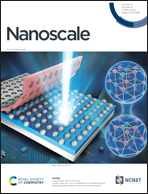Interlaced Pd–Ag nanowires rich in grain boundary defects for boosting oxygen reduction electrocatalysis†
Abstract
Given the high cost and poisoning issues of Pt, developing Pd-based catalysts as substitutes is highly essential. Although substantial progress has been made, the synthesis of Pd-based electrocatalysts with both high activity and stability in the oxygen reduction reaction (ORR) remains a challenge. In this work, we prepared Pd–Ag nanowires with up to micro-sized length and a diameter of ∼17 nm via a facile modified polyol method. The obtained Pd–Ag nanowires (NWs) exhibit interlaced features and are rich in grain boundary defects. Due to the continuous grain boundaries in the one-dimensional (1D) structure and the optimized composition, the synthesized Pd1Ag1 NWs show half-wave potential of 0.897 V and mass activity of 0.103 A mg−1 in alkaline media toward ORR, higher than those of both state-of-the-art Pt/C and other Pd–Ag counterparts. Significantly, after stability tests over 5000 cycles, Pd1Ag1 NWs shows a 2 mV positive shift, much better than that of Pt/C, exhibiting striking stability for ORR. This work may provide an avenue to construct advanced catalysts by surface defect engineering.



 Please wait while we load your content...
Please wait while we load your content...